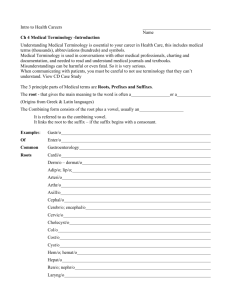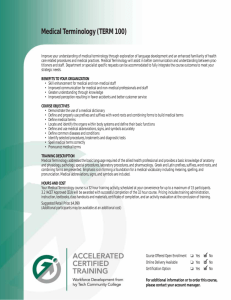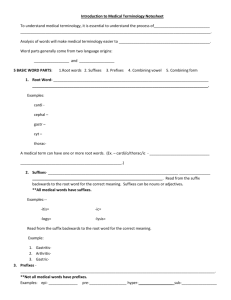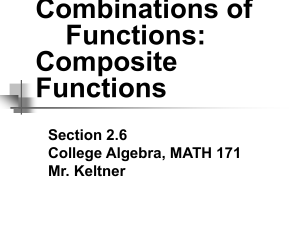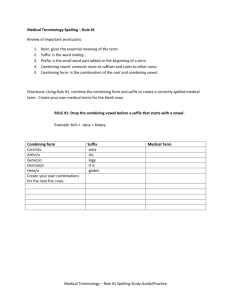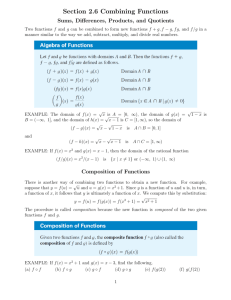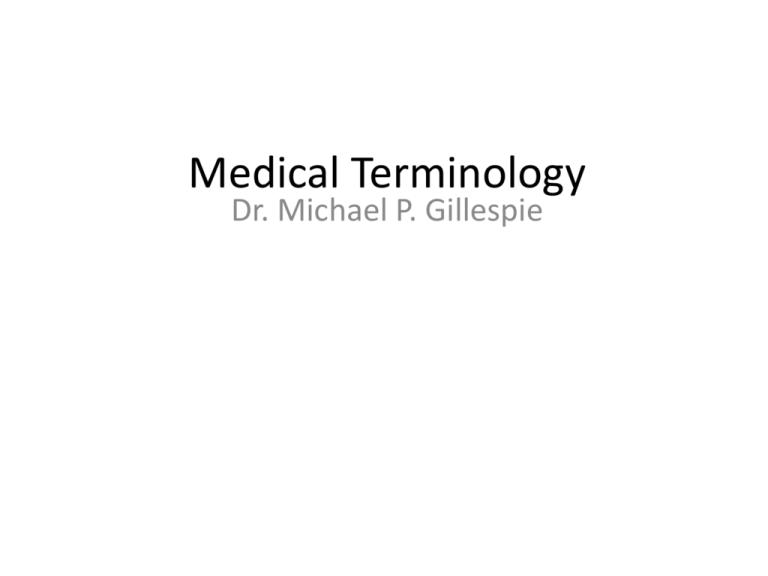
Medical Terminology
Dr. Michael P. Gillespie
Categories of Medical Terms
• Descriptive – descriptive medical terms
describes the shape, size, color, function etc. of
the anatomical structure.
• Eponyms – literally “putting a name upon” - are
used to honor someone who first discovered or
described an anatomical structure, diagnosed a
disease, or developed a medical instrument or
procedure.
– Eponyms give no useful information about what the
item is or where it is located.
Objectives
•
Analyze words by dividing them into component parts.
–
–
•
Relate the medical terms to the structure and function of the human body.
–
•
Do not simply memorize terms.
Break words up into their component parts.
The medical terms will be easier to understand if you know their context in health and disease
processes.
Be aware of spelling and pronunciation problems.
–
–
Some medical terms are pronounced alike, but spelled differently (i.e. ilium and ileum).
Some medical terms are similar and a mispronunciation can lead to a misunderstanding (i.e.
urethra and ureter).
Elements of medical terms
• Root – the root is the foundation of the word. All medical words have one or more
roots.
• Prefix – word beginning. Usually identifies some subdivision or part of the central
meaning.
• Suffix – word ending. Modifies the central meaning.
• Combining vowel – usuallu an “o”. Links the root to a suffix or another root.
• Combining form – combination of the root plus the combining vowel.
3 General Rules
• 1. Read the meaning of the medical terms
from the suffix back to the beginning of the
term and across.
• 2. Drop the combining vowel (usually o)
before a suffix beginning with a vowel:
gastritis not “gastroitis”.
• 3. Keep the combining vowel between two
roots: gastroenterology, not “gastrentology”.
Common prefixes and suffixes
• Itis = inflammation (tonsillitis, appendicitis,
hepatitis)
• Osis = abnormal condition (cyanosis)
• Ectomy = to cut out [remove] (appendectomy,
tonsillectomy)
• Otomy = to cut into (tracheotomy)
• Ostomy = to make a [mouth] (colostomy)
• A / an = without / none (anemia, areflexia)
Common prefixes and suffixes
• Micro = small (microscopic)
• Macro = large (macroscopic)
• Mega / megaly = enlarged (megacolon, organomegaly)
• Scopy / scopic = to look / observe (colonoscopy)
• Graphy / graph = recording an image (mammography)
• Gram = the image (mammogram)
• Ology / ologist = study / specialize in (cardiologist, rheumatology)
Word Roots for organs
Root
Meaning
Example
Stomato
Mouth
Stomatitis
Dento
Teeth
Dentist
Glosso / linguo
Tongue
Glossitis, lingual gland
Gingivo
Gums
Gingivitis
Encephalo
Brain
Encephalitis
Gastro
Stomach
Gastritis
Entero
Intestine
Gastroenteritis
Colo
Large intestine
Colitis, megacolon
Word Roots for organs
Root
Meaning
Example
Procto
Anus / rectum
Proctitis, proctologist
Hepato
Liver
Hepatitis, hepatomegaly
Nephro / rene
Kidney
Nephrosis, renal
Orchiso
Testis
Orchiditis
Oophoro
Ovary
Oophorectomy
Hystero / metro
Uterus
Hysterectomy,
endometritis
Salpingo
Uterine tubes
Hysterosalpingogram
Dermo
Skin
Dermatitis
Word Roots for organs
Root
Meaning
Example
Masto / mammo
Breast
Mammography,
mastectomy
Osteo
Bones
Osteoporosis
Cardio
Heart
Electrocardiogram
Cysto
Bladder
Cystitis
Rhino
Nose
Rhinitis
Phlebo / veno
Veins
Phlebitis, phlebotomy
Pneumo / pulmo
Lung
Pneumonitis,
pulmonologist
Hemo / emia
Blood
Hematologist, anemia
Colors
Structural Organization of the
Body
• CELL—the fundamental unit of all living things
Study Section 1
•
•
•
•
•
•
•
metabolism
anabolism
catabolism
cell membrane
chromosomes
cytoplasm
DNA
• endoplasmic
reticulum
• genes
• Karyotype
• mitochondria
• nucleus
Body Cavities
• Body cavities are the
spaces within the body
that contain internal
organs (viscera).
Organs of the Abdominopelvic
and Thoracic Cavities
Abdominopelvic Regions
Abdominopelvic Quadrants
Anatomical Divisions of the
Back
Positional and Directional Terms
Positional and Directional Terms
Chapter 5
Digestive System
21
Introduction:
Ingestion and Digestion
• Ingestion—Food material taken into mouth
• Digestion—Food is broken down and travels
through the gastrointestinal tract.
– Digestive enzymes aid breakdown of complex
nutrients.
• Proteins → amino acids
• Sugars → glucose
• Fats → fatty acids or triglycerides
Introduction:
Absorption
• Digested food passes into
bloodstream through lining cells of
small intestine.
• Nutrients travel to all cells of the
body
• Cells burn nutrients to release
energy stored in food.
Small Intestine
Villi in the lining of the small intestine
Large Intestine
Parts of the large intestine
Liver, Gallbladder, and
Pancreas
Parts of the liver, gallbladder, and pancreas
Chapter 7
Urinary System
Copyright © 2011, 2008, 2005 by Saunders, an imprint of Elsevier Inc. All rights reserved.
28
Anatomy of the
Major Organs (cont’d)
Organs of the
Urinary System
in a Male
Anatomy of the
Major Organs (cont’d)
Female Urinary System
How Kidneys Produce Urine
(cont’d)
Blood enters kidneys
through right and left
renal arteries
Arterioles carry blood
to capillaries
Glomeruli filter blood
How Kidneys Produce Urine
(cont’d)
• Glomerulus and
a renal tubule combine to
form a unit called a
nephron.
How Kidneys Produce Urine
(cont’d)
All collecting tubules lead
to the renal pelvis
Calyces or calices are
small, cuplike regions of
the renal pelvis
Illustration shows section of kidney
Chapter 8
Female Reproductive System
34
Introduction
Gametes
(ovum and sperm cell)
Gametes are produced in the
gonads.
Female gonads are the ovaries;
male gonads are the testes.
Introduction
Fertilization
An ovum leaves the ovaries and travels
through the fallopian tube.
Fertilization takes place if sperm cells.
are present and unite with the ovum.
Fertilized egg implants then divides to
form a ball of cells, called a zygote (and
later an embryo and then a fetus).
Organs of the
Female Reproductive System
Organs of the female reproductive system, lateral
view.
Organs of the
Female Reproduction System
Organs of the female reproductive system
anterior view
Organs of the Female Reproductive System
● The Breast
sagittal view
Menstruation and Pregnancy
A, Implantation in the uterus
B, Embryo’s relationship to the placenta
Terminology: Combining Forms,
Suffixes, and Prefixes
COMBINING FORMS
Combining Form
Meaning
• amni/o
amnion
• cervic/o
cervix, neck
• chori/o
chorion
• chorion/o chorion
• colp/o
vagina
Terminology: Combining Forms,
Suffixes, and Prefixes
COMBINING FORMS
Combining Form
culd/o
episi/o
galact/o
gynec/o
hyster/o
Meaning
cul-de-sac
vulva
milk
woman, female
uterus, womb
Terminology: Combining Forms,
Suffixes, and Prefixes
COMBINING FORMS
Combining Form
•
•
•
•
•
Meaning
lact/o milk
mamm/o
breast
mast/o
breast
men/o
menses, menstruation
metr/o
uterus
Terminology: Combining Forms,
Suffixes, and Prefixes
COMBINING FORMS
Combining Form
•
•
•
•
•
Meaning
my/o muscle
myom/o muscle tumor
nat/i
birth
obstetr/o midwife
o/o
egg
Terminology: Combining Forms,
Suffixes, and Prefixes
COMBINING FORMS
Combining Form
Meaning
• oophor/o ovary
•
•
•
•
ov/o
egg
ovari/o
ovary
ovul/o
egg
perine/o perineum
Terminology: Combining Forms,
Suffixes, and Prefixes
COMBINING FORMS
Combining Form
• phor/o
•
•
•
•
salping/o
uter/o
vagin/o
vulv/o
Meaning
to bear
fallopian tubes
uterus
vagina
vulva
Terminology: Combining Forms,
Suffixes, and Prefixes
SUFFIXES
Suffix
Meaning
• -arche
beginning
• -cyesis
• -gravida
• -parous
pregnancy
pregnancy
to bear, bring forth
Terminology: Combining Forms,
Suffixes, and Prefixes
SUFFIXES
Suffix
• -rrhea
Meaning
discharge
• -salpinx
uterine tube
• -tocia labor, birth
• -version act of turning
Terminology: Combining Forms,
Suffixes, and Prefixes
PREFIXES
Suffix
• dys-
•
•
•
•
endoinintramulti-
Meaning
painful
within
in
within
many
Terminology: Combining Forms,
Suffixes, and Prefixes
PREFIXES
Suffix
Meaning
• nulli-
no, not, none
• pre• primi• retro-
before
first
backward
Chapter 9
Male Reproductive System
51
Anatomy
Anatomy
Internal structure of the testis and the epididymis
Terminology
Combining Form
Meaning
andr/o
male
balan/o
penis
cry/o
cold
crypt/o
hidden
epididym/o
epididymis
gon/o
seed
hydr/o
water, fluid
orch/o, orchi/o,
testis, testicle
orchid/o
Terminology
Combining Form
pen/o
prostat/o
semin/i
sperm/o
terat/o
test/o
varic/o
vas/o
zo/o
Meaning
penis
prostate gland
semen, seed
spermatozoa, semen
monster
testis, testicle
varicose veins
vessel duct
animal life
Terminology
SUFFIXES
Suffix
• -genesis
Meaning
formation
• -one
hormone
• -pexy
fixation, put in place
• -stomy
new opening
Pathologic Conditions
Cardiovascular
System
Anatomy of the Heart
Conduction System of the Heart
Combining Forms
and Terminology
Combining Form
Meaning
angi/o
vessel
aort/o
aorta
arter/o
artery
arteri/o artery
ather/o
yellowish plaque
atri/o atrium
Combining Forms
and Terminology
Combining Form
Meaning
brachi/o arm
cardi/o
heart
cholesterol/o cholesterol
coron/o heart
cyan/o
blue
myx/o
mucus
Combining Forms
and Terminology
Combining Form
•
•
•
•
•
•
Meaning
ox/o
oxygen
pericardi/o pericardium
phleb/o vein
sphygm/o pulse
steth/o
chest
thromb/o clot
Combining Forms
and Terminology
Combining Form
•
•
•
•
•
•
Meaning
valvul/o valve
valv/o
valve
vas/o vessel
vascul/o vessel
ven/o, ven/i vein
ventricul/o ventricle
Cardiovascular
System and Blood
Cell Types and Function
Erythrocytes: red blood cells transport
nutrients and oxygen
Leukocytes: white blood cells
Thrombocytes: platelets; clot blood
Combining Forms
and Terminology
Combining Form
Meaning
bas/o
base
chrom/o
color
coagul/o
clotting
cyt/o
cell
eosin/o
red, dawn, rosy
erythr/o
red
Terminology
Combining Form
•
•
•
•
•
•
Meaning
granul/o
granules
hem/o
blood
hemat/o
blood
hemoglobin/o hemoglobin
is/o
same, equal
kary/o
nucleus
Combining Forms
and Terminology
Combining Form
leuk/o
mon/o
morph/o
myel/o
neutr/o
nucle/o
Meaning
white
one, single
shape, form
bone marrow
neutral
nucleus
Terminology
Combining Form
phag/o
poikil/o
sider/o
spher/o
thromb/o
Meaning
eat, swallow
varied, irregular
iron
globe, round
clot
Suffixes
-apheresis
-blast
-cyte
-cytosis
-emia
-globin
-globulin
-lytic
•
•
•
•
•
•
•
•
-oid
-osis
-penia
-phage
-philia
-phoresis
-poiesis
-stasis
Chapter 14
Lymphatic and Immune Systems
72
Location of Lymph Nodes
Lymph Nodes
Spleen
• Destroys old red blood cells
• Filters microorganisms
•
•
and other foreign material
out of the blood
Activates lymphocytes
during blood filtration (B
cells produce antibodies)
Stores blood, especially
erythrocytes (RBCs) and
platelets
Thymus Gland
• Provides immunity in
•
•
fetal life and in early
years of growth.
Makes cells
immunocompetent in
early life
Early removal from an
animal impairs its ability
to make antibodies and
produce cells to fight
antigens
Immune System
Natural immunity: genetic predisposition
• Phagocytosis
• Macrophages
• Natural killer cells
Combining Forms, Prefixes,
and Terminology
COMBINING FORMS
Combining Form
Meaning
immun/o
protection
lymph/o
lymph
lymphaden/o
lymph node
splen/o
spleen
thym/o
thymus gland
tox/o
poison
Combining Forms, Prefixes,
and Terminology
PREFIXES
Prefix
Meaning
ana-
again, anew
inter-
between
Chapter 12
Respiratory System
80
Respiratory Anatomy
Mediastinum: Middle of chest where trachea
divides into two branches
Bronchi: Each leads to a separate lung
Lungs: Lobes are not mirror images
Hilum: Blood vessels, nerves, lymphatic
tissue, and bronchial tubes enter and exit
Anatomy of Respiration
Vocabulary
adenoids
alveolus (alveoli)
apex of the lung
base of the lung
brochioles
bronchus (bronchi)
carbon dioxide
Vocabulary
•
•
•
•
•
•
•
•
cilia
diaphragm
epiglottis
expiration
glottis
hilum
inspiration
larynx
Vocabulary
•
•
•
•
•
•
•
lobe
mediastinum
nares
oxygen
palatine tonsil
paranasal sinus
parietal pleura
Vocabulary
•
•
•
•
•
•
•
pharynx
pleura
pleural cavity
pulmonary parenchyma
respiration
trachea
visceral pleura
Combining Forms
and Terminology
Combining Form
Meaning
adenoid/o adenoids
alveol/o alveolus, air sac
bronch/o bronchial tube
bronchi/o bronchus
bronchiol/o bronchiole, small bronchus
capn/o
carbon dioxide
Combining Forms
and Terminology
Combining Form
Meaning
coni/o
dust
cyan/o
blue
epiglott/o epiglottis
laryng/o larynx, voice box
lob/o lobe of the lung
mediastin/o mediastinum
Combining Forms
and Terminology
Combining Form
Meaning
nas/o nose
orth/o
straight, upright
ox/o
oxygen
pector/o chest
pharyng/o pharynx, throat
phon/o
voice
Combining Forms
and Terminology
Combining Form
Meaning
phren/o diaphragm
pleur/o
pleura
pneum/o air, lung
pneumon/o lung
pulmon/o lung
rhin/o
nose
Combining Forms
and Terminology
Combining Form
Meaning
sinus/o
sinus cavity
spir/o breathing
tel/o
complete
thorac/ochest
tonsill/o tonsils
trache/o trachea, windpipe
Combining Forms, Suffixes, and
Terminology
SUFFIXES
Suffix
-ema
-osmia
-pnea
-ptysis
-sphyxia
-thorax
Meaning
condition
smell
breathing
spitting
pulse
pleural cavity, chest
Chapter 15
Musculoskeletal System
93
Bone Formation
Ossification: replacement of cartilage with
bone
Cells:
osteoblast: produce immature bony tissue that
replaces cartilage
osteocyte: nourishes and maintains bone
osteoclast: reabsorb or digest bone (remodels
bone)
Bone Structure
(A) Divisions of a
long bone and
interior
structure
(B) composition of
compact
(cortical) bone
Bone Structure
Ends of bones covered by articular cartilage in
the joint: cushions joint and allows it to move
smoothly
Compact bone: contains haversian systems for
blood vessels, nerves, and yellow bone
marrow (mostly fat)
Cancellous (spongy/trabecular bone): spaces
contain red bone marrow with elements for
blood formation
Bone Marrow
• Yellow marrow: chiefly fat
• Red marrow: rich with blood vessels and
immature and mature blood cells in various
stages of development; in later life replaced
with yellow marrow
• Ribs, pelvic bone, sternum, vertebrae,
epiphyses of long bones
Bone Processes and Depressions
Processes: serve as attachments for
muscles and tendons
Depressions: openings or hollow regions
help join bones or serve as passageways for
nerves and/or vessels
Bone Processes and Depressions
Vertebral Column and Vertebrae
Terminology — Bones
GENERAL TERMS
COMBINING FORMS
Combining Form
Meaning
calc/o calcium
calci/o
calcium
kyph/o
posterior curvature in
thoracic region
lamin/o
lamina
lord/o
curve
lumb/o
loins, lower back
Terminology — Bones
GENERAL TERMS
COMBINING FORMS
Combining Form
myel/o
orth/o
oste/o
scoli/o
spondyl/o
vertebr/o
Meaning
bone marrow
straight
bone
crooked
vertebra
vertebra
Terminology — Bones
GENERAL TERMS
SUFFIXES
Suffix
Meaning
-blast embryonic cell
-clast to break
-listhesisslipping
-malacia softening
-physis
to grow
-porosis pore, passage
-tome instrument to cut
Terminology — Bones
TERMS RELATED TO SPECIFIC BONES
COMBINING FORMS
Combining Form
Meaning
acetabul/o acetabulum (hip socket)
calcane/o calcaneus (heal)
carp/o carpals (wrist bones)
clavicul/oclavicle (collar bone)
cost/o ribs
crani/o
cranium (skull)
Terminology — Bones
TERMS RELATED TO SPECIFIC BONES
COMBINING FORMS
Combining Form
Meaning
femor/o femur (thigh bones)
fibul/o
fibula (smaller lower leg bone)
humer/ohumerus (upper arm bone)
ili/o
ilium (upper part of pelvic bone)
ischi/o
ischium (part of pelvic bone)
malleol/o malleolus
Terminology — Bones
TERMS RELATED TO SPECIFIC BONES
COMBINING FORMS
Combining Form
Meaning
mandibul/o mandible (lower jaw bone)
maxill/o maxilla (upper jaw bone)
metacarp/o metacarpals (hand bones)
metatars/o metatarsals (foot bones)
olecran/o olecranon (elbow)
patell/o
patella (kneecap)
pelv/i pelvis
Terminology — Bones
TERMS RELATED TO SPECIFIC BONES
COMBINING FORMS
Combining Form
perone/o
phalang/o
pub/o
radi/o
scapul/o
Meaning
fibula
phalanges (finger, toe bones)
pubis
radius
scapula (shoulder blade)
Terminology — Bones
TERMS RELATED TO SPECIFIC BONES
COMBINING FORMS
Combining Form
Meaning
stern/o
sternum (breastbone)
tars/o
tarsals
tibi/o tibia (shin bone)
uln/o ulna (lower arm bone)
Joints
Joint (articulation): coming together of two or
more bones
Suture joints: immovable (skull)
Synovial joints: freely movable (ball and socket
types, e.g., hip or shoulder), (hinge type, for
example, elbow, knee, ankle)
Synovial Joints
Joint capsule surrounds bone.
Ligaments band bones together.
Bones are covered by articular cartilage.
Synovial membrane lies under capsule and
lines synovial cavity; filled with synovial fluid.
Bursae
Closed sacks of synovial fluid with a synovial
membrane located near, but not within a
joint. Needed where sliding must take place
Common sites:
between tendons (connective tissue connecting
muscle to bone) and bones
between ligaments (binding bone to bone) and
bones
between skin and bones (with prominent bony
anatomy)
Terminology — Joints
COMBINING FORMS
Combining Form
Meaning
ankyl/o
stiff
arthr/o
joint
articul/o
burs/o
joint
bursa
chondr/o cartilage
Terminology — Joints
COMBINING FORMS
Combining Form
Meaning
• ligament/o ligament
• rheumat/o watery flow
• synov/o
• ten/o
• tendin/o
synovial membrane
tendon
tendon
Terminology — Joints
SUFFIXES
Suffix
Meaning
-desis to bind, tie together
-stenosis narrowing
Muscles
• Three types of muscles: striated, smooth, cardiac
• Striated: under voluntary control—they move all the bones
as well as face and eyes
• Smooth: control is involuntary—they move internal organs
(digestive tract, blood vessels, ducts of glands)
• Cardiac: not consciously controlled and found exclusively in
the heart
Terminology — Muscles
COMBINING FORMS
Combining Form
Meaning
fasci/o
facia
fibr/o fibrous
leiomy/o smooth muscle
my/o muscle
Terminology — Muscles
COMBINING FORMS
Combining Form
Meaning
myocardi/o heart muscle
myos/o
muscle
plant/o
sole of the foot
rhabdomy/o skeletal muscle
connected to bones
Terminology – Muscles
SUFFIXES
Suffix
Meaning
-asthenia lack of strength
-trophy
development,
nourishment
Terminology – Muscles
PREFIXES
Prefix
•
•
•
•
abaddorsipoly-
Meaning
away from
toward
back
many, much
Chapter 16
Skin
Structure of the Skin
Epidermis: outermost, thin cellular
membrane
Dermis: next layer; dense fibrous,
connective tissue
Subcutaneous tissue (hypodermis): thick,
fat-containing tissue
Structure of the Skin
Acessory Organs of the Skin
HAIR: cells filled with the hard protein;
keratin
Hair follicles: shafts that hold the hair
Five million hairs on body; 100,000 on head
Melanocytes at the root form the color
Grow .5 inch (1.3 cm) per month
Cutting does not affect growth
Accessory Organs of Skin
NAILS: hard keratin plates
covering toes and fingers
lunula
cuticle
paronychium
Accessory Organs of Skin
GLANDS: sebaceous and sweat
Sebaceous glands secrete oily sebum into
hair follicle to lubricate.
Sweat glands secrete into pores to moisten
and cool.
Both are subject to bacterial growth.
Accessory Organs of Skin
Sebaceous gland, eccrine sweat gland, and
apocrine sweat gland.
Combining Forms
COMBINING FORMS
Combining Form
Meaning
adip/o
albin/o
caus/o
cauter/o
cutane/o
derm/o/
fat
white
burn, burning
heat, burn
skin
skin
Combining Forms
COMBINING FORMS
Combining Form
•
•
•
•
•
•
Meaning
dermat/o skin
diaphor/o profuse sweating
erythem/o redness
erythemat/o redness
hidr/o
sweat
ichthy/o scaly, dry
Combining Forms
COMBINING FORMS
Combining Form
Meaning
kerat/o
hard, horny tissue
leuk/o
white
lip/o
fat
melan/o black
myc/o
fungus
onych/o nail
Combining Forms
COMBINING FORMS
Combining Form
•
•
•
•
•
•
Meaning
phyt/o
plant
pil/o
hair, hair follicle
py/o
pus
rhythid/o wrinkle
seb/o sebum
squam/o scalelike
Combining Forms
COMBINING FORMS
Combining Form
steat/o
fat
trich/o
hair
ungu/o
nail
xanth/o yellow
xer/o dry
Meaning
Colors
Chapter 18
Endocrine System
133
Introduction
Endocrine System
Glands release hormones.
Hormones regulate the many and varied
functions of an organism.
Hormones bind to receptors.
Receptors are recognition sites in the
various target tissues on which hormones
act.
Introduction
Endocrine System
ENDOCRINE glands—
Secrete their hormones directly into
the bloodstream
EXOCRINE glands—
Send chemical substances (tears,
sweat, milk, saliva) via ducts to the
outside of the body
Endocrine Glands
thyroid gland
parathyroid glands (four glands)
adrenal glands (one pair)
pancreas (islets of Langerhans)
pituitary gland
ovaries (one pair)
testes (one pair)
pineal gland
thymus gland
The Endocrine System
Combining Forms, Suffixes,
Prefixes, and Terminology
GLANDS
Combining Form
•
•
•
•
•
•
Meaning
aden/o
gland
adren/o adrenal glands
adrenal/o adrenal glands
gonad/o sex glands (ovaries, testes)
pancreat/opancreas
parathyroid/o parathyroid gland
Combining Forms, Suffixes,
Prefixes, and Terminology
GLANDS
Combining Form
Meaning
• pituitar/o pituitary gland; hypophysis
• thyr/o
thyroid gland
• thyroid/o thyroid gland
Combining Forms, Suffixes,
Prefixes, and Terminology
RELATED FORMS
Combining Form
•
•
•
•
•
•
•
Meaning
andr/o
male
calc/o, calici/o calcium
cortic/o
cortex, outer region
crin/o
secrete
dips/o
thirst
estr/o
female
gluc/o, glyc/o
sugar
Combining Forms, Suffixes,
Prefixes, and Terminology
GLANDS
Combining Form
•
•
•
•
•
•
Meaning
home/o sameness
hormon/o hormone
kal/I
potassium (an electrolyte)
lact/o milk
myx/o
mucus
natr/o
sodium (an electrolyte)
Combining Forms, Suffixes,
Prefixes, and Terminology
GLANDS
Combining Form
•
•
•
•
•
•
Meaning
phys/o
growing
somat/o body
ster/o
solid structure
toc/o childbirth
toxic/o
position
ur/o
urine
Combining Forms, Suffixes,
Prefixes, and Terminology
SUFFIXES
Suffix
•
•
•
•
•
Meaning
-agon assemble, gather together
-emia blood condition
-in, -ine
a substance
-tropin
stimulating the function of
-uria
urine condition
Combining Forms, Suffixes,
Prefixes, and Terminology
PREFIXES
Prefix
•
•
•
•
•
•
•
euhyperhypooxypantetratri
Meaning
good, normal
excessive, above
deficient, below
rapid, sharp, acid
all
four
three
Chapter 19
Cancer Medicine (Oncology)
Introduction
Cancer: characterized by unrestrained and
excessive growth of cells
Malignant tumors: compress, invade and
destroy surrounding tissues
Characteristics of Tumors
Neoplasms (Tumors): growths that
arise from normal tissue
Malignant
Benign
Multiply rapidly
Invasive and infiltrative
Undifferentiated
Metastasize
•
•
•
•
Grow slowly
Encapsulated
Differentiated
Don’t spread
What Causes Cancer?
Carcinogenesis: transformation of a
normal cell to a cancerous one
Damage to genetic material
DNA function
Mitosis
Protein synthesis
•
•
•
•
Genes
Nucleotides
Mutation
Apoptosis
Combining Forms
COMBINING FORMS
alveol/o
cac/o
carcin/o
cauter/o
chem/o
cry/o
cyst/o
fibr/o
follicul/o
fung/i
medull/o
mucos/o
mut/a
mutagen/o
onc/o
papill/o
pharmac/o
plas/o
ple/o
polyp/o
prot/o
radi/o
sarc/o
scirrh/o
xer/o
Suffixes
-blastoma
-genesis
-oma
-plasia
-plasm
-suppression
-therapy
Prefixes
anaapobrachyepimetatele-

